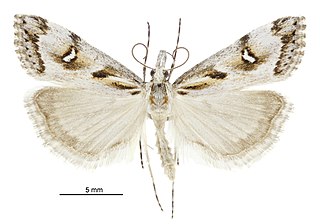| Imma nephallactis | |
|---|---|
| Scientific classification | |
| Domain: | Eukaryota |
| Kingdom: | Animalia |
| Phylum: | Arthropoda |
| Class: | Insecta |
| Order: | Lepidoptera |
| Family: | Immidae |
| Genus: | Imma |
| Species: | I. nephallactis |
| Binomial name | |
| Imma nephallactis Meyrick, 1906 | |
Imma nephallactis is a moth in the family Immidae. It was described by Edward Meyrick in 1906. It is found in Venezuela. [1]
The wingspan is 17–20 mm. The forewings are grey or fuscous sometimes variably sprinkled or suffused with white, sometimes strongly violet tinged. There is a black variably interrupted line beneath the costa from the base to the middle, edged beneath anteriorly by a fine pale yellowish line, and a dark fuscous or blackish costal spot at one-fourth, and sometimes one near the base, sometimes confluent. A thick irregular dentate dark fuscous line runs from this spot, not reaching the dorsum, usually cut by a fine white line on the submedian fold and there is a dark fuscous or blackish transverse mark in the disc at two-thirds, terminating beneath in a round suffused spot, and two spots on the costa before the middle and at two-thirds separated by a white space, the whole sometimes merged into a large semi-oval dark fuscous costal blotch reaching two-thirds of the way across the wing. There are two or three dark fuscous subdorsal marks and a series of dark fuscous or blackish marks from four-fifths of the costa to the tornus, angulated above the middle, where there is a larger spot, and sometimes a dark fuscous streak running from the discal mark through the angle to the termen. A waved-dentate pale terminal line is preceded by a dark fuscous shade. The hindwings are rather darker posteriorly, especially in males. [2]
